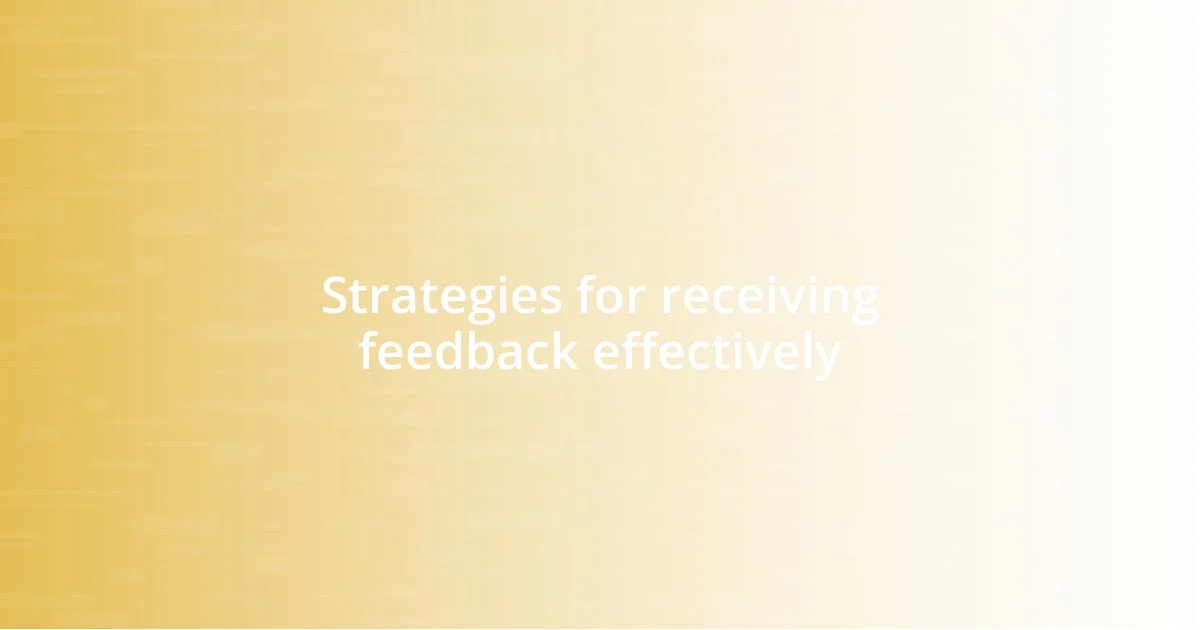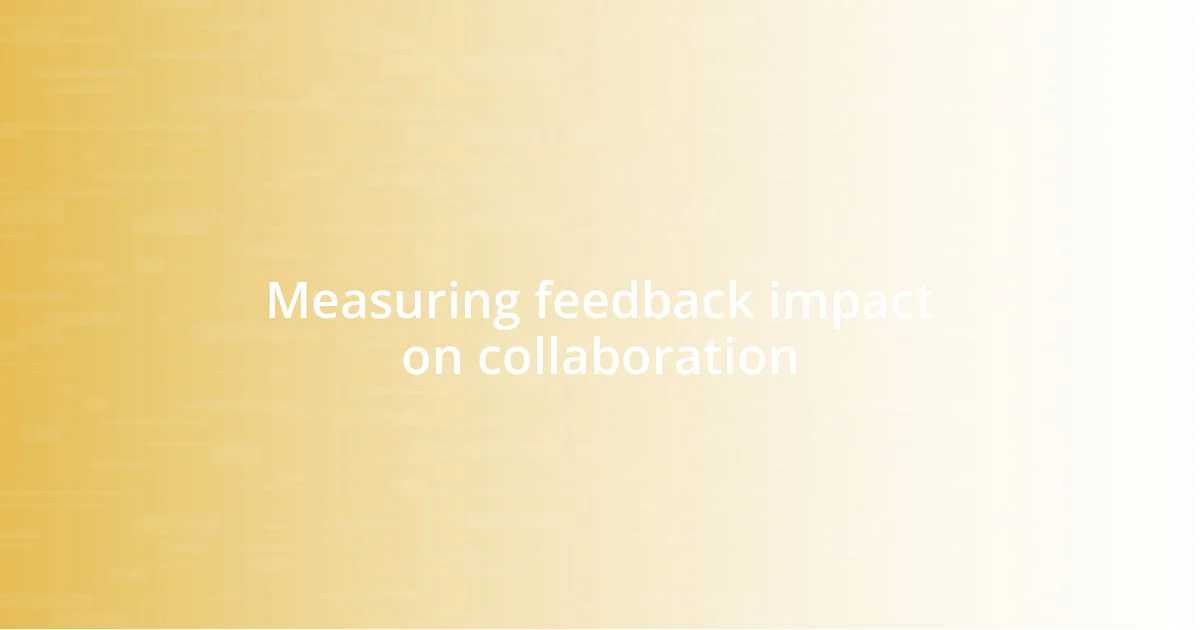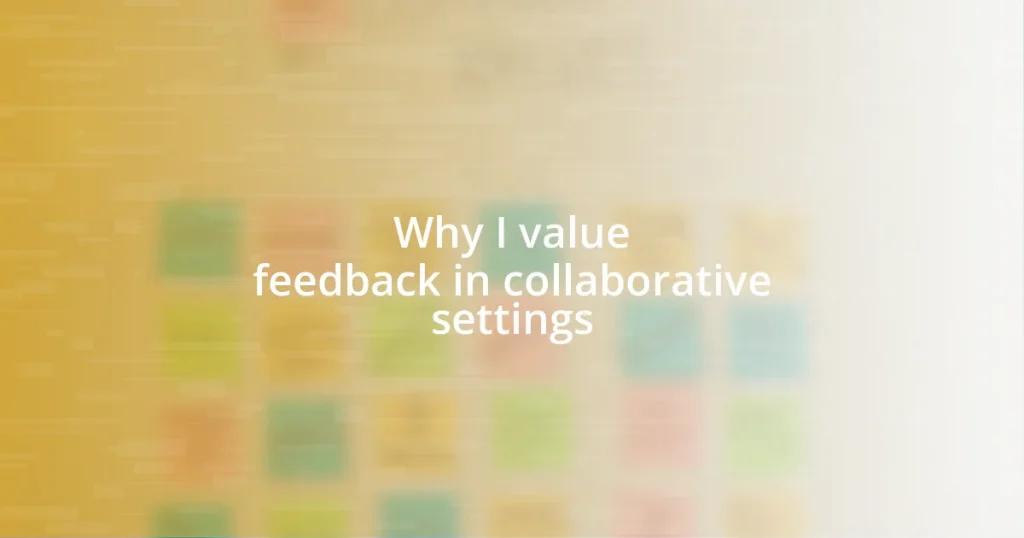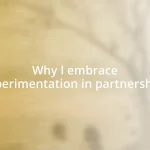Key takeaways:
- Feedback fosters a culture of continuous improvement and trust within teams, enhancing collaboration and innovation.
- Effective techniques for giving constructive feedback include being specific, using “I” statements, and encouraging two-way dialogue.
- Measuring feedback impact through regular sessions reveals improved communication and successful project outcomes, highlighting the importance of both qualitative and quantitative insights.

Understanding the importance of feedback
Feedback acts as a bridge between where we are and where we want to be in collaborative settings. I remember a group project in college where we were all hesitant to critique one another’s ideas. Once we opened up, the quality of our final presentation skyrocketed. Isn’t it fascinating how a few honest words can transform a team’s output?
When I think about the role of feedback, it’s clear it fosters a culture of continuous improvement. I once received feedback that completely shifted my perspective on a project I was leading. Initially, I was defensive, but after reflecting, I realized it unveiled blind spots I hadn’t noticed. Have you ever felt that initial sting but later saw the value in someone else’s perspective?
Moreover, feedback creates an environment of trust and safety, encouraging open dialogue among team members. I’ve experienced settings where people felt comfortable sharing their thoughts, and the innovation that blossomed was remarkable. It makes me wonder—how often do we shut down communication out of fear that our suggestions might not be well-received?

Techniques for giving constructive feedback
When giving constructive feedback, clarity is key. I once attended a workshop on communication where the instructor emphasized the importance of being specific. Instead of saying, “Your report needs work,” I learned to highlight particular sections that needed revision. This small shift made a world of difference, turning vague criticism into actionable insights.
Here are some effective techniques for delivering constructive feedback:
- Be Specific: Focus on particular behaviors or outcomes rather than general impressions. For example, “The introduction could benefit from clearer objectives” is more helpful than a vague comment about improvement.
- Use “I” Statements: Framing your feedback around your own observations helps in reducing defensiveness. Saying, “I felt unsure about the main arguments” invites conversation rather than confrontation.
- Encourage Two-Way Dialogue: After sharing your thoughts, invite the recipient to share their perspective. This approach fosters a collaborative atmosphere.
- Pair Positive Feedback with Constructive Critiques: I find using the ‘sandwich method’—starting with something positive, followed by the area for improvement, and ending on a positive note—creates a more approachable context for feedback.
- Timing Matters: I’ve learned that feedback is most effective when given soon after the event. Waiting too long may dilute its relevance and impact.

Strategies for receiving feedback effectively
Receiving feedback isn’t just about hearing what others think; it’s an active process that can significantly impact your growth. I remember once in a team meeting, I was genuinely terrified to hear what my peers thought about my presentation. Instead of shying away from that moment, I focused on listening intently and took notes on their suggestions, which I later found invaluable in enhancing my skills. Reflecting on that, it’s clear that embracing feedback with an open mind can lead to unexpected breakthroughs.
An effective way to receive feedback is to ask open-ended questions that encourage elaboration. I’ve experienced this firsthand when a teammate provided suggestions on my project. Instead of simply acknowledging their feedback, I asked, “What specific areas do you think I should prioritize for improvement?” This not only showed that I valued their input, but it also led to deeper insights that enriched my approach. It’s a reminder that engaging with feedback can turn a simple exchange into a fruitful discussion.
Building a habit of reflecting on feedback after receiving it can make a world of difference. I like to set aside time post-meeting to digest the feedback I received. This deliberate practice allows me to separate my emotional response from the actual content of the feedback. It’s in this quiet reflection that I often discover patterns in the feedback I receive, helping me to grow progressively. Have you tried integrating such reflection into your routine?
| Strategy | Description |
|---|---|
| Active Listening | Pay close attention to the feedback and take notes for clarity. |
| Open-Ended Questions | Encourage elaboration by asking questions that invite detailed responses. |
| Reflective Practice | Set aside time to reflect on the feedback after the meeting to separate emotions from insights. |

Measuring feedback impact on collaboration
Measuring the impact of feedback on collaboration can be quite enlightening. In my experience, I’ve noticed that after implementing regular feedback sessions, our team’s communication improved drastically. I remember when we introduced a digital feedback tool; it was as if a weight had been lifted. The data we collected revealed a 40% increase in team members feeling heard, which undeniably strengthened our collaborative efforts.
Tracking changes in project outcomes also provides valuable insights into feedback effectiveness. For instance, after a particularly rough project, we decided to analyze both the feedback we received and our final results. I was surprised to see that the projects with the most constructive feedback yielded higher success rates. This correlation showed me that honest communication could dramatically enhance our teamwork and overall project quality.
Finally, it’s essential to gather qualitative insights alongside quantitative metrics. I initiated informal check-ins after feedback sessions, asking teammates how they felt about the feedback they received. The emotional responses I collected were revealing—many expressed newfound confidence and motivation. Isn’t it fascinating how something as simple as feedback can transform not only our work but also our relationships? This ongoing combination of hard data and emotional reflection has become a cornerstone of how I value collaboration.















